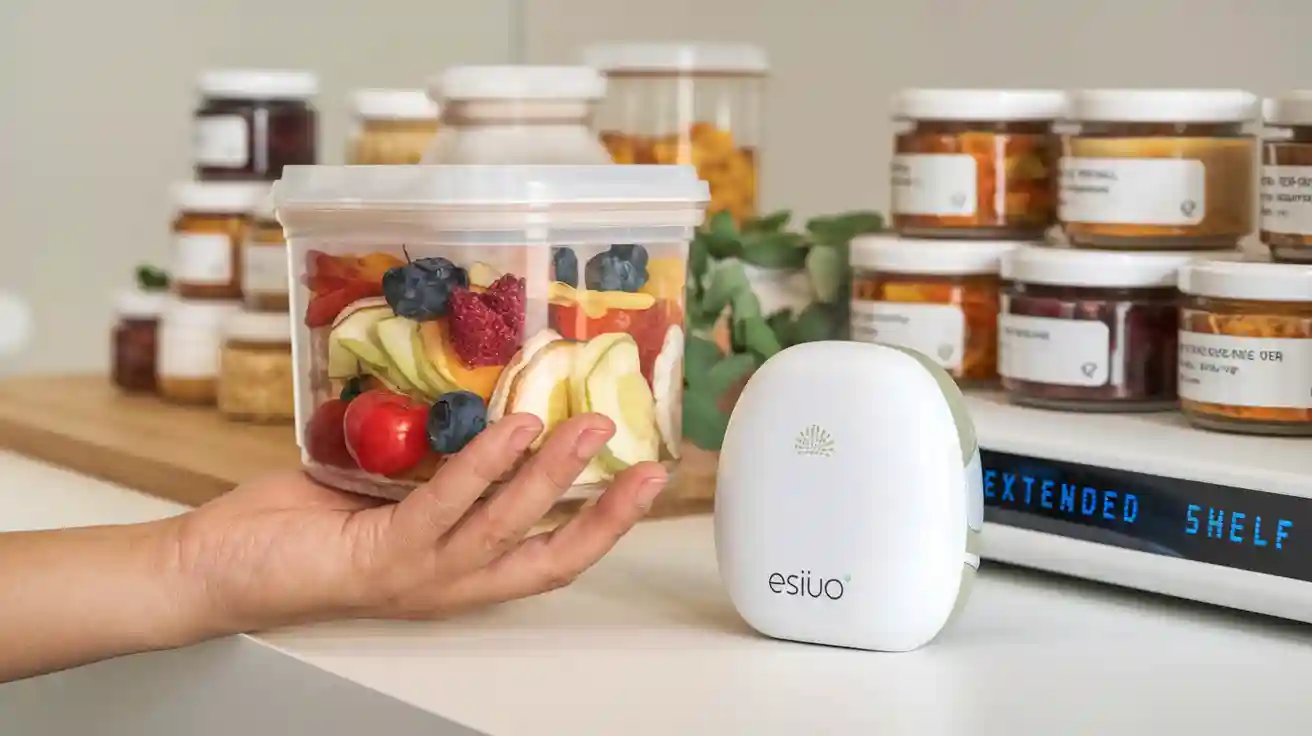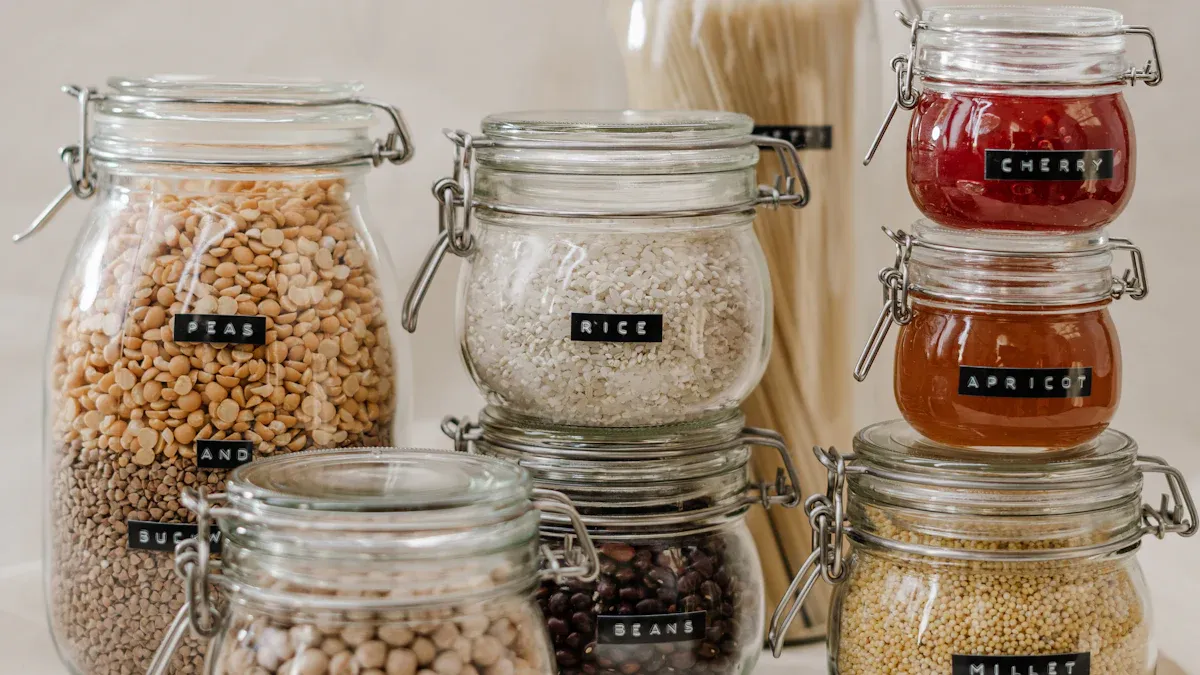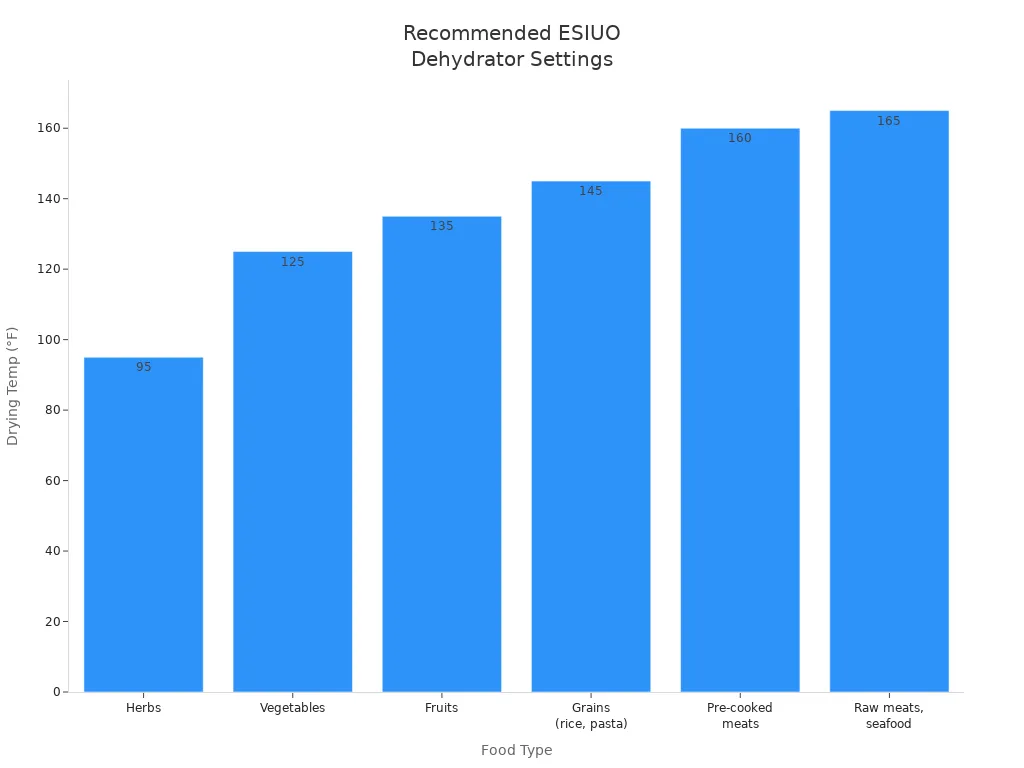
You often wonder how long does dehydrated food last. When you use ESIUO dehydrators, you control dehydration with advanced features. Dehydration removes water, so food stays fresh longer. You keep your snacks safe and tasty when you follow the right steps.
How Long Does Dehydrated Food Last?

You might ask yourself, how long does dehydrated food last? The answer depends on the type of food, how you store it, and the methods you use during dehydration. ESIUO dehydrators help you get the best results, but you still need to follow some important steps to keep your food safe and tasty for as long as possible.
Shelf Life by Food Type
Different foods have different shelf lives after dehydration. You need to know how long does dehydrated food last for each type so you can plan your storage and meals.
- Dehydrated vegetables usually last the longest. When you store them in airtight containers in a cool, dark place, they can stay good for up to 15 to 20 years.
- Dehydrated fruits also last a long time, often up to 15 years if you keep them dry and away from light.
- Dehydrated meats have a much shorter shelf life. If you use regular airtight containers, you should eat them within two weeks. If you store them in a cool, dark place, you can stretch that to about two months. For the longest shelf life, vacuum seal the meat with oxygen absorbers and freeze it. This can keep it safe for up to 30 years or more.
- Foods like honey, salt, sugar, and oats can last over 30 years when dehydrated and stored properly.
Here is a table to help you see how long does dehydrated food last for different types:
| Food Type / Preservation Method | Shelf Life Range | Notes |
|---|---|---|
| Dehydrated dried fruits, vegetables, powders | 15-20 years | Typical dehydrated products |
| Dehydrated honey, salt, sugar, hard wheat, oats | 30+ years | Longest shelf life among dehydrated foods |
| Dehydrated meat (airtight, cool, dark) | 2 weeks – 2 months | Short shelf life unless vacuum sealed/frozen |
| Freeze-dried fruits, vegetables, meals, meats | 25-30 years | Longer shelf life due to more moisture removal |
Tip: Always check for off smells, mold, or changes in color before eating stored dehydrated food.
Storage Conditions and Their Impact
How long does dehydrated food last also depends on where and how you store it. Good storage keeps your food safe and fresh for much longer.
- Store your dehydrated food in a cool, dark place. Heat and light can make food spoil faster and destroy nutrients.
- Use airtight containers. This keeps out moisture and stops mold and bacteria from growing.
- Vacuum sealing helps remove oxygen, which slows down spoilage and keeps food tasting fresh.
- Keep the temperature between 50°F and 70°F. Higher temperatures can cut the shelf life in half.
- Protect your food from insects and rodents by using strong containers and keeping food off the ground.
- Use Mylar bags with moisture absorbers for extra protection.
- Label your containers with the date so you know how long your food has been stored.
- Check your food often for signs of spoilage, like mold or bad smells.
| Factor | Effect on Dehydrated Food Longevity | Mitigation Strategies |
|---|---|---|
| Temperature | Higher temperatures speed up spoilage and reduce shelf life. | Store in cool places. |
| Humidity | High humidity lets moisture in, causing mold and spoilage. | Use airtight containers and dry environments. |
| Light | Light breaks down vitamins and causes discoloration. | Store in dark places or use opaque packaging. |
Note: If you open containers often, moisture can get in and spoil your food faster.
Common Mistakes That Reduce Shelf Life
You want your dehydrated food to last as long as possible. Avoid these common mistakes to make sure you get the most out of your efforts:
- Overcrowding trays in your dehydrator stops air from moving and leaves some food wet.
- Cutting food into thick slices means it dries unevenly and can spoil.
- Using too much heat can make the outside dry too fast, trapping moisture inside.
- Skipping steps like blanching or pretreating can lead to poor color and less nutrition.
- Storing food in containers that are not airtight lets in moisture and air, which causes spoilage.
- Ignoring the recommended drying times can leave food too wet or too dry.
- Not rotating trays during dehydration can cause some pieces to dry more than others.
- Mixing foods with different drying times can lead to some being over-dried and others under-dried.
- Not checking the humidity in your drying area can slow down the process and increase spoilage.
- Rushing the process or skipping steps can cut the shelf life in half.
Remember: Moisture and oxygen are the biggest enemies of dehydrated food. Always seal your food well and store it in the right conditions.
If you follow these tips and use your ESIUO dehydrator correctly, you will know exactly how long does dehydrated food last and enjoy safe, delicious snacks for years.
ESIUO Dehydrators: What Sets Them Apart
Superior Moisture Removal
When you use an ESIUO dehydrator, you get more than just a basic machine. ESIUO models stand out because they focus on safe, even, and thorough dehydration. You can trust that your food will dry completely, which helps prevent spoilage and keeps your snacks fresh. Here are some features that make ESIUO unique:
- Food-grade, BPA-free plastics and stainless steel keep your food safe.
- Easy-to-use controls let you adjust settings without confusion.
- Even drying means every piece of food gets the same attention.
- Multi-tray designs give you options for small or large batches.
- Compact models fit different kitchen spaces.
- Flexible settings match many food dehydration needs.
Tip: Even moisture removal is key to long shelf life and better taste.
Precision Temperature and Airflow Control
ESIUO dehydrators give you control over temperature and airflow. This helps you dry different foods safely and keep nutrients locked in. The table below shows how ESIUO’s settings help you get the best results:
| Aspect | Details |
|---|---|
| Temperature Control Range | 90-100°F for herbs, 130-160°F for fruits/vegetables, 145-160°F for meats/jerky |
| Food Safety | Drying meats at 145-160°F stops bacteria from growing |
| Nutrient Preservation | Lower temperatures keep vitamins and minerals in fruits and vegetables |
| Avoiding Over/Under Drying | Adjustable thermostat and timer prevent spoilage and nutrient loss |
| Material Safety | Food-grade materials prevent chemical contamination |
| Even Drying | Smart fans and tray design give you consistent results |
Consistent Results Every Time
You want your dehydration process to work the same way each time. ESIUO dehydrators use precise temperature control and energy-saving technology to give you steady, reliable results. While some brands may dry food faster, ESIUO focuses on making sure every batch comes out just right. You can count on your snacks to be safe, tasty, and ready for storage.
The Science Behind ESIUO’s Extended Shelf Life
Moisture Reduction and Microbial Growth
When you use an ESIUO dehydrator, you remove water from food. This step is important because microbes need water to grow and multiply. Without enough moisture, bacteria, mold, and yeast cannot spoil your food. Here’s how moisture reduction helps:
- Dehydration lowers water activity, making it hard for microbes to survive.
- Microorganisms cannot divide or carry out their life processes without water.
- Drying methods like air drying or using a dehydrator remove water by evaporation.
- Less water means less chance for spoilage and longer shelf life.
Note: Foods for long-term storage should have about 10% or less moisture. If you keep moisture low, you stop most bacteria and mold from growing.
Temperature Regulation for Preservation
You control the temperature with ESIUO dehydrators. This helps you dry food safely and keep nutrients. If you use too much heat, you might lose vitamins and change the taste. If you use too little, you may not remove enough water. ESIUO lets you set the right temperature for each food. This balance keeps your food safe and tasty for years. Modern dehydrators work at low, steady temperatures to protect heat-sensitive nutrients like vitamins A and C. When you combine proper temperature with even airflow, you get food that lasts longer and keeps its quality.
Optimized Air Circulation
Air circulation matters when you dry food. ESIUO dehydrators use smart fans and vents to move air evenly. This design helps every piece of food dry at the same rate. Good airflow prevents hot spots and uneven drying, which can cause spoilage. Research shows that better air movement leads to more uniform drying and less waste. You get food that is safe, dry, and ready for storage.
Best Practices for Maximizing Shelf Life with ESIUO
Preparing Food for Dehydration
You can get the best results by preparing your food carefully before dehydration. Start by slicing fruits and vegetables evenly, about 1/4 to 1/2 inch thick. This helps them dry at the same rate. Cut meats even thinner for better drying. Blanch vegetables by boiling them briefly, then cooling them in ice water. This step keeps their color and flavor. Soak fruit slices in lemon juice or citric acid to stop browning. Always remove fat from meats, since fat can spoil quickly. Cook meats to safe temperatures—at least 160°F for beef and 165°F for poultry—before drying. Avoid drying foods with strong odors together, and never try to dehydrate high-fat foods or dairy.
Blanching and pre-treating foods help keep their color, nutrients, and texture. These steps also make your dried foods safer and last longer.
Using ESIUO Settings for Best Results
ESIUO dehydrators let you choose the right temperature for each food. Herbs dry best at 95°F, vegetables at 125°F, and fruits at 135°F. For grains, use 145°F. Always dry pre-cooked meats at 160°F and raw meats or seafood at 165°F. Watch the drying process and rotate trays for even results. Avoid using high heat, which can trap moisture inside and cause spoilage. ESIUO’s precise controls help you keep nutrients and flavor while making sure your food is safe.

Storing Dehydrated Food Properly
After dehydration, store your food in airtight containers. Mylar bags with oxygen absorbers work well for long-term storage. Glass jars and food-grade plastic buckets lined with Mylar also protect your food. Keep your containers in a cool, dry, and dark place. Vacuum sealing can extend shelf life up to 10 years by blocking air and moisture. Always label your containers with the date and check them regularly for freshness.
Store dehydrated foods in airtight containers in cool, dry, dark places to prevent spoilage and keep nutrients.
ESIUO dehydrators help you keep food fresh and safe for up to 2 years.
- You get even drying and nutrient retention, which reduces food waste.
- Smart controls and eco-friendly design support healthy, sustainable living.
- Future dehydrators may use infrared heating and smart systems for even longer shelf life.
FAQ
How do you know if dehydrated food has spoiled?
You should check for mold, off smells, or changes in color. If you see or smell anything unusual, do not eat the food.
Can you rehydrate food dried with an ESIUO dehydrator?
Yes, you can. Just soak the food in water or broth until it returns to its original texture.
Do you need to use oxygen absorbers for storage?
You do not have to, but using oxygen absorbers helps keep your dehydrated food fresh and safe for a longer time.


